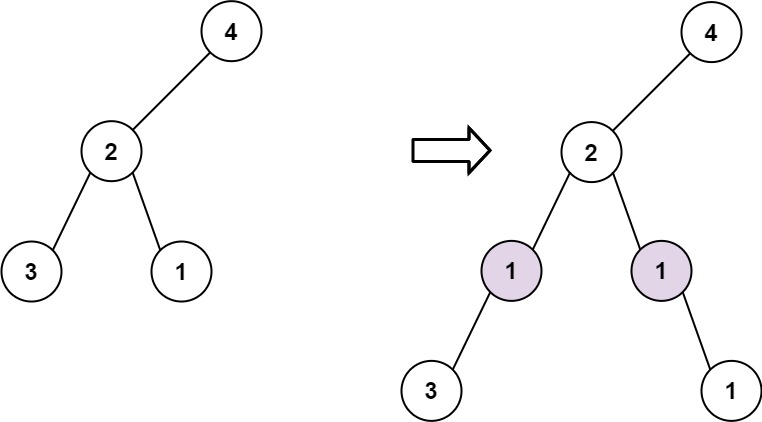[LeetCode] 623. Add One Row to Tree
Given the root of a binary tree and two integers val and depth, add a row of nodes with value val at the given depth depth.
Note that the root node is at depth 1.
The adding rule is:
- Given the integer
depth, for each not null tree nodecurat the depthdepth - 1, create two tree nodes with valuevalascur's left subtree root and right subtree root. cur's original left subtree should be the left subtree of the new left subtree root.cur's original right subtree should be the right subtree of the new right subtree root.- If
depth == 1that means there is no depthdepth - 1at all, then create a tree node with valuevalas the new root of the whole original tree, and the original tree is the new root's left subtree.
Example 1:

Input: root = [4,2,6,3,1,5], val = 1, depth = 2 Output: [4,1,1,2,null,null,6,3,1,5]
Example 2:

Input: root = [4,2,null,3,1], val = 1, depth = 3 Output: [4,2,null,1,1,3,null,null,1]
Constraints:
- The number of nodes in the tree is in the range
[1, 104]. - The depth of the tree is in the range
[1, 104]. -100 <= Node.val <= 100-105 <= val <= 1051 <= depth <= the depth of tree + 1
在二叉树中增加一行。
给定一个二叉树的根 root 和两个整数 val 和 depth ,在给定的深度 depth 处添加一个值为 val 的节点行。
注意,根节点 root 位于深度 1 。
加法规则如下:
给定整数 depth,对于深度为 depth - 1 的每个非空树节点 cur ,创建两个值为 val 的树节点作为 cur 的左子树根和右子树根。
cur 原来的左子树应该是新的左子树根的左子树。
cur 原来的右子树应该是新的右子树根的右子树。
如果 depth == 1 意味着 depth - 1 根本没有深度,那么创建一个树节点,值 val 作为整个原始树的新根,而原始树就是新根的左子树。来源:力扣(LeetCode)
链接:https://leetcode.cn/problems/add-one-row-to-tree
著作权归领扣网络所有。商业转载请联系官方授权,非商业转载请注明出处。
这道题我提供两种做法,BFS和DFS,思路是一样的,都是从根节点往下,一直遍历到 d - 1 层,然后把新的节点加进去。
首先是BFS,我们用queue遍历到目标层 d 的上一层 d - 1,然后对着d - 1 层,先把他的左孩子右孩子用temp指针保存起来,再把需要增加的节点加进去。注意唯一的corner case就是如果新的节点需要加在第一层的话,返回的就是新的根节点了。
时间O(n)
空间O(n)
Java实现
1 /** 2 * Definition for a binary tree node. 3 * public class TreeNode { 4 * int val; 5 * TreeNode left; 6 * TreeNode right; 7 * TreeNode(int x) { val = x; } 8 * } 9 */ 10 class Solution { 11 public TreeNode addOneRow(TreeNode root, int v, int d) { 12 // corner case 13 if (d == 1) { 14 TreeNode newRoot = new TreeNode(v); 15 newRoot.left = root; 16 return newRoot; 17 } 18 19 // normal case 20 // BFS遍历node一直到d - 1层 21 Queue<TreeNode> queue = new LinkedList<>(); 22 queue.offer(root); 23 for (int i = 1; i < d - 1; i++) { 24 int size = queue.size(); 25 for (int j = 0; j < size; j++) { 26 TreeNode cur = queue.poll(); 27 if (cur.left != null) { 28 queue.offer(cur.left); 29 } 30 if (cur.right != null) { 31 queue.offer(cur.right); 32 } 33 } 34 } 35 36 // 把新一层的node接在第d - 1和第d层之间 37 while (!queue.isEmpty()) { 38 TreeNode cur = queue.poll(); 39 TreeNode temp = cur.left; 40 cur.left = new TreeNode(v); 41 cur.left.left = temp; 42 temp = cur.right; 43 cur.right = new TreeNode(v); 44 cur.right.right = temp; 45 } 46 return root; 47 } 48 }
DFS,可以直接参见代码。
时间O(n)
空间O(n)
Java实现
1 /** 2 * Definition for a binary tree node. 3 * public class TreeNode { 4 * int val; 5 * TreeNode left; 6 * TreeNode right; 7 * TreeNode(int x) { val = x; } 8 * } 9 */ 10 class Solution { 11 public TreeNode addOneRow(TreeNode root, int v, int d) { 12 // corner case 13 if (d == 1) { 14 TreeNode newRoot = new TreeNode(v); 15 newRoot.left = root; 16 return newRoot; 17 } 18 // normal case 19 helper(v, root, 1, d); 20 return root; 21 } 22 23 private void helper(int val, TreeNode root, int curDepth, int d) { 24 if (root == null) { 25 return; 26 } 27 if (curDepth == d - 1) { 28 TreeNode temp = root.left; 29 root.left = new TreeNode(val); 30 root.left.left = temp; 31 temp = root.right; 32 root.right = new TreeNode(val); 33 root.right.right = temp; 34 } else { 35 helper(val, root.left, curDepth + 1, d); 36 helper(val, root.right, curDepth + 1, d); 37 } 38 } 39 }



